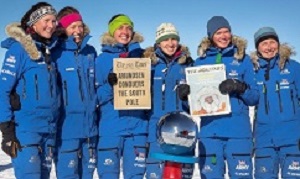 Women who underwent extreme physical training and completed a trans-Antarctic expedition did not show any more negative health effects than would be expected in men, according to a study. Lead author Dr Robert Gifford said, "Our findings contain some potentially myth-busting data on the impact of extreme physical activity on women."
Women who underwent extreme physical training and completed a trans-Antarctic expedition did not show any more negative health effects than would be expected in men, according to a study. Lead author Dr Robert Gifford said, "Our findings contain some potentially myth-busting data on the impact of extreme physical activity on women."
The study presented at the Society for Endocrinology annual conference in Glasgow is the first to suggest that women are not more susceptible to the negative effects of physical exertion and, that with appropriate training and preparation, can be as resilient as men in undertaking arduous physical activity.
It has been reported that the female reproductive system and stress responses are more sensitive to the negative effects of extreme physical activity. There is some evidence that arduous physical activity can suppress normal female reproductive hormone activity, impair bone strength and elevate stress hormone levels to a greater extent than in men. However, the reasons underlying these reported gender differences in response to extreme endurance exercise remain poorly understood.
Dr Robert Gifford and colleagues from the University of Edinburgh, the Royal Centre for Defence, Leeds Beckett University, Northumbria and Newcastle NHS Trusts, Wansbeck General and Royal Victoria Infirmary, Newcastle-upon-Tyne, and the University of Newcastle, examined the effects of extreme exercise on hormone levels and the health of six women participating in the first all-female trans-antarctic expedition.
The researchers monitored several markers of their health before and after the successful expedition. These included indicators of stress, reproductive and metabolic hormone levels, body weight and bone strength. The findings indicated not only that markers of reproductive function and bone strength were preserved, but that some markers showed evidence of delayed, exercise-related benefit to their physical fitness two weeks after the expedition.
Gifford states, "Our findings contain some potentially myth-busting data on the impact of extreme physical activity on women. We have shown that with appropriate training and preparation, many of the previously reported negative health effects can be avoided."
Although the Ice Maiden team consisted of just six women and it was not possible to account for confounding factors such as age or ethnicity, these findings do suggest adherence to a comprehensive training schedule may have mitigated any negative health effects. The team now plan to further investigate how different types of activities can contribute to negative effects on stress and energy balance caused by physical exertion, which may help in the generation of transferrable strategies that prevent them in future.
Gifford comments, "These findings could have important relevance for men and women in arduous or stressful employment, where there is concern that they are damaging their health. If an appropriate training and nutritional regime is followed, their health may be protected."
Abstract
Higher short-term exercise-associated reproductive, psychological and bone health-related outcomes have been reported in women than men, although the reasons for this are poorly understood. The first, all-female transantarctic expedition provided a unique opportunity to perform an observational study examining concurrent effects of extreme exercise on pertinent hormonal axes to reproductive dysfunction and associated pathology. Body composition was measured by dual-energy xray absorptiometry (DXA) one and two months before and 15 days after the expedition. Basal metabolic and endocrine markers and 1-hour dynamic adrenal and pituitary gonadotroph tests, were conducted before, and 4–5 and 15–16 days after the expedition. Monthly hair cortisol was measured before and during the expedition. Basal bone turnover markers (BTMs) and high-resolution peripheral quantitate computerised tomography (HRpQCT) were assessed before and after the expedition. Six women (median (range) 32.7 (28.6–36.1) years) hauled 80 kg sledges 1700 km in 61 days, becoming the first all-female team to complete an Antarctic traverse. Mean (SD) weight loss was 9.37 (2.31) kg, entirely constituting fat mass; lean mass was unchanged. Basal sex steroids, corticosteroids and metabolic markers were largely unaffected by the expedition, except leptin and vitamin D, which fell during the expedition and recovered after 11 days. LH reactivity was suppressed prior to and during the expedition, recovering after 11 days, while FSH did not change during or after the expedition. Cortisol reactivity did not change during or after the expedition, although the HPA axis demonstrated marked sensitivity to central suppression. Monthly average cortisol was elevated during the expedition. BTMs revealed uncoupling before and during the expedition, resolving after 11 days. Tibial stiffness and fracture threshold were unchanged after the expedition. This study is unprecedented in women, demonstrating marked resilience in reproductive function, the HPA axis and bone, suggesting that female biological capacity for extreme endurance exercise is greater than anticipated.
Authors
Robert Gifford, Thomas O’Leary, Julie Greeves, Richard Anderson, Rebecca Reynolds, David Woods
[link url="https://www.sciencedaily.com/releases/2018/11/181119064145.htm"]Society of Endocrinology material[/link]
[link url="https://www.endocrine-abstracts.org/ea/0059/ea0059oc1.1.htm"]Endocrine Abstracts[/link]
